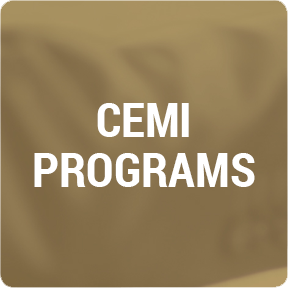November 13th, 2014 at 3:30pm
933 Ramsey Lake Road, Sudbury, Ontario
Willet Green Miller Centre
4th Floor – CEMI Training Room
Registration:
To register for this lecture, please contact Courtney Folz at cfolz@miningexcellence.ca or 705.673.6568.
There is no fee to attend this lecture, but seating is limited. Register today!
Metered parking is available in the Fraser Parking Lot across from the Willet Green Miller Centre.
Lecture Topic: Required Data and Computational Techniques to Investigate Deformation and Stability around Underground Mine Excavations in Three Dimensions
Lecture Abstract: Deformation and stability around underground mine excavations depend on the following factors: 1. Lithological system that exists in the rock mass; 2. Major discontinuity geometry system (large scale features) of the rock mass; 3. Minor discontinuity geometry pattern (small scale features) that exist in each lithology; 4. Intact rock and rock mass physical and mechanical properties of each lithological unit of the rock mass; 5. Mechanical properties of the discontinuities of the rock mass; 6. In-situ stress system of the rock mass; 7. Applied boundary conditions to the rock mass; 8. Water conditions in the rock mass if applicable and 9. Dynamic loading conditions which may be applicable to the rock mass due to blasting and earthquakes. Usually the lithological system and the major discontinuity pattern that exist in the rock mass are very complex. Currently available sophisticated, powerful three-dimensional (3-D) stress analyses software do not have the capability of modeling such complexity. Therefore, the lithological system and the major discontinuity network should be modeled separately before importing them to 3-D stress analyses software to perform 3-D discontinuum stress analyses. Examples of such modeling through previously conducted case studies will be covered in the presentation. Sampling of minor discontinuity geometry data either through manual or remote fracture mapping techniques is subject to sampling biases. In addition, minor discontinuity geometrical parameters exhibit high variability. Therefore, sampling bias corrections need to be applied using geometrical probability techniques before inferring probability distributions for each of the minor discontinuity geometry parameter using probability and statistical techniques. It is important to note that such procedures are not available in the 3-D stress analyses software available at present. Therefore, modeling of discontinuity minor discontinuity geometry parameters need to be performed separately before importing the results of them to 3-D stress analyses software. Examples of such modeling through previously conducted case studies will be covered in the presentation. Rock mass mechanical properties exhibit anisotropic scale dependent properties. The procedures that are used to estimate rock mass mechanical properties using rock mass classification systems do not have the capability of capturing the anisotropic scale dependent properties. Please note that rock mass classification system indices such as RMR, Q and GSI are scalars. On the other hand, both the rock mass strength and deformability change with the direction. Therefore, they are tensors. This presentation will cover estimation of rock mass strength and deformability parameters incorporating intact rock properties and minor discontinuity geometry and capturing the scale effects and anisotropy through a previously conducted case study. In most numerical modeling studies very little attention is paid in estimating the discontinuity mechanical properties comprehensively either through laboratory or field tests. This presentation will cover procedures to estimate all the needed mechanical properties of discontinuities to perform 3-D discontinuum stress analyses. Variability and uncertainty of estimated mechanical properties for rock masses and discontinuities are unavoidable. Therefore, sensitivity or probabilistic analyses should be performed to evaluate the effect of the said material parameter variability and uncertainty. Because a large number of material parameters are used in performing the 3-D stress analyses, the number of combinations of stress analyses that need to be performed will be large. This leads to very high computational time. This presentation will cover how to reduce the total number of combinations and thus the computational time using the statistical experimental design techniques. The complicated lithological system and the discontinuity network that exist in the rock mass play a major role on the in-situ stress system. This will be shown through case studies in the presentation. Then one can ask the question “Can we use the measured in-situ stress system in the field in performing 3-D numerical stress analysis”. This aspect will be discussed in the presentation. Numerical stress analyses results depend on the boundary conditions applied to the numerical model. This will be shown through case studies in the presentation. In addition, use of appropriate boundary conditions in 3-D numerical modeling will be discussed in the presentation. All the aforementioned, clearly indicate the uncertainty we run into in predicting the deformation and stability around underground excavations in 3-D. This means it is necessary to compare the numerical predictions with measured field deformations and stresses. Such comparisons will be shown in the presentation using previously conducted case studies.
Speaker: Dr. Pinnaduwa H.S.W. Kulatilake is a Professor of Geotechnical Engineering and Director of Rock Mass Modeling and Computational Rock Mechanics Laboratories at the University of Arizona. He is a registered Professional Civil Engineer in California. He received his B.Sc. (in 1976) in Civil Engineering from the University of Sri Lanka, Peradeniya, MS (in 1978) in Soil Engineering from the Asian Institute of Technology, Bangkok, Thailand and Ph.D. (in 1981) in Civil Engineering (with geotechnics emphasis) from the Ohio State University, USA. He has over 34 years of experience in rock mechanics & rock engineering associated with mining, civil and petroleum engineering, geotechnical engineering, and applications of probabilistic and numerical methods to geo-engineering.

